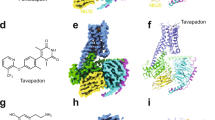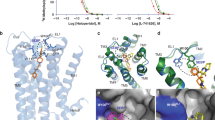Abstract
Purpose
The D3 dopamine receptor exhibits tolerance and slow response termination (SRT) properties that are not exhibited by the closely-related D2 dopamine receptor. We previously demonstrated that the induction of tolerance elicits a unique conformational change in the D3 receptor. Here we tested the hypothesis that the tolerance and SRT properties of the D3 receptor are ligand-dependent.
Methods
We used pharmacophore modeling and in silico screening approaches coupled with electrophysiological and biochemical methods to identify and functionally characterize the novel dopamine receptor agonists.
Results
We identified cis-8-OH-PBZI (PBZI), FAUC73 and an additional novel compound, ES609, which although they are full D3 receptor agonists, do not induce the tolerance and SRT properties of the D3 receptor. In addition, PBZI has full intrinsic activity at D2L, is a partial agonist at D2S and exhibits functional selectivity at D4.2 dopamine receptors. ES609 is a partial agonist at D2S, D2L and D4.2 receptors, and exhibits functional selectivity at D2L and D4.2 dopamine receptors.
Conclusion
We have discovered a novel class of atypical dopamine receptor agonists that include three structurally dissimilar compounds. These new agonists will help determine the physiological and pathophysiological relevance of D3 receptor tolerance and SRT properties.









Similar content being viewed by others
Abbreviations
- cAMP:
-
cyclic adenosine monophosphate
- EC:
-
extracellular
- EC50 :
-
half-maximal effective concentration
- GIRK:
-
G protein–coupled inward rectifier potassium
- GPCR:
-
G protein–coupled receptor
- hERG:
-
human ether-à-go-go related gene
- HSB:
-
hybrid structure–based
- IBMX:
-
3-isobutyl-1-methylxanthine
- IC:
-
intracellular
- MAP:
-
mitogen-activated protein
- MD:
-
molecular dynamics
- OPLS:
-
optimized potentials for liquid simulations
- PBZI:
-
cis-8-hydroxy-3-(n-propyl)-1,2,3a,4,5,9b-hexahydro-1H-benz[e]indole hydrobromide
- POPC:
-
1-palmitoyl-2-oleoyl-sn-glycero-3-phosphocholine
- RMSD:
-
root mean square deviation
- SRT:
-
slow response termination
- TM:
-
transmembrane
- β2-AR:
-
β2-adrenergic receptor
REFERENCES
Ahlgren-Beckendorf JA, Levant B. Signaling mechanisms of the D3 dopamine receptor. J Recept Signal Transduct Res. 2004;24(3):117–30.
Robinson SW, Caron MG. Selective inhibition of adenylate cyclase type V by the dopamine D3 receptor. Mol Pharmacol. 1997;52:508–14.
Cussac D, Newman-Tancredi A, Pasteau V, Millan MJ. Human dopamine D(3) receptors mediate mitogen-activated protein kinase activation via a phosphatidylinositol 3-kinase and an atypical protein kinase C-dependent mechanism. Mol Pharmacol. 1999;56(5):1025–30.
Westrich L, Kuzhikandathil EV. The tolerance property of human D3 dopamine receptor is determined by specific amino acid residues in the second cytoplasmic loop. Biochimica et Biophysica Acta- MCR. 2007;1773:1747–58.
Seabrook GR, Kemp JA, Freedman SB, Patel S, Sinclair HA, McAllister G. Functional expression of human D3 dopamine receptors in differentiated neuroblastoma X glioma NG108-15 cells. Br J Pharmacol. 1994;111:391–3.
Werner P, Hussy N, Buell G, Jones KA, North RA. D2, D3, and D4 dopamine receptors couple to G protein-regulated potassium channels in Xenopus oocytes. Mol Pharmacol. 1996;49:656–61.
Kuzhikandathil EV, Yu W, Oxford GS. Human dopamine D3 and D2L receptors couple to inward rectifier potassium channels in mammalian cell lines. Mol Cell Neurosci. 1998;12:390–402.
Kuzhikandathil EV, Oxford GS. Activation of human D3 dopamine receptor inhibits P/Q-type calcium channels and secretory activity in AtT-20 cells. J Neurosci. 1999;19(5):1698–707.
Kuzhikandathil EV, Oxford GS. Dominant-negative mutants identify a role for GIRK channels in D3 dopamine receptor-mediated regulation of spontaneous secretion activity. J Gen Physiol. 2000;115:697–706.
Kuzhikandathil EV, Bartoszyk GD. The novel antidyskinetic drug sarizotan elicits different functional responses at human D2-like dopamine receptors. Neuropharmacol. 2006;51:873–84.
Kuzhikandathil EV, Westrich L, Bakhos S, Pasuit J. Identification and characterization of novel properties of the human D3 dopamine receptor. Mol Cell Neurosci. 2004;26:144–55.
Westrich L, Gil-Mast S, Kortagere S, Kuzhikandathil EV. Development of tolerance in D3 dopamine receptor signaling is accompanied by distinct changes in receptor conformation. Biochem Pharmacol. 2010;79:897–907.
Kortagere S, Welsh WJ. Development and application of hybrid structure based method for efficient screening of ligands binding to G-protein coupled receptors. J Comput Aided Mol Des. 2006;20(12):789–802.
Chien EY, Liu W, Zhao Q, Katritch V, Han GW, Hanson MA, et al. Structure of the human dopamine D3 receptor in complex with a D2/D3 selective antagonist. Science. 2010;330(6007):1091–115.
Cherezov V, Rosenbaum DM, Hanson MA, Rasmussen SG, Thian FS, Kobilka TS, et al. High-resolution crystal structure of an engineered human beta2-adrenergic G protein-coupled receptor. Science. 2007;318(5854):1258–65.
Sali A, Blundell TL. Comparative protein modelling by satisfaction of spatial restraints. J Mol Biol. 1993;234(3):779–815.
Kortagere S, Cheng SY, Antonio T, Zhen J, Reith ME, Dutta AK. Interaction of novel hybrid compounds with the D3 dopamine receptor: Site-directed mutagenesis and homology modeling studies. Biochem Pharmacol. 2011;81(1):157–63.
Jones G, Willett P, Glen RC. Molecular recognition of receptor sites using a genetic algorithm with a description of desolvation. J Mol Biol. 1995;245(1):43–53.
Eldridge MD, Murray CW, Auton TR, Paolini GV, Mee RP. Empirical scoring functions: I. The development of a fast empirical scoring function to estimate the binding affinity of ligands in receptor complexes. J Comput Aided Mol Des. 1997;11(5):425–45.
Kevin J, Bowers EC, Xu H, Dror RO, Eastwood MP, Gregersen BA, et al. Scalable Algorithms for Molecular Dynamics Simulations on Commodity Clusters. Proceedings of the ACM/IEEE Conference on Supercomputing (SC06), New York, NY, IEEE; 2006.
Lipinski CA, Lombardo F, Dominy BW, Feeney PJ. Experimental and computational approaches to estimate solubility and permeability in drug discovery and development settings. Adv Drug Deliv Rev. 2001;46(1–3):3–26.
Kortagere S, Chekmarev D, Welsh WJ, Ekins S. New predictive models for blood–brain barrier permeability of drug-like molecules. Pharm Res. 2008;25(8):1836–45.
Kortagere S, Chekmarev D, Welsh WJ, Ekins S. Hybrid scoring and classification approaches to predict human pregnane X receptor activators. Pharm Res. 2009;26(4):1001–11.
Chekmarev DS, Kholodovych V, Balakin KV, Ivanenkov Y, Ekins S, Welsh WJ. Shape signatures: new descriptors for predicting cardiotoxicity in silico. Chem ResToxicol. 2008;21(6):1304–14.
Scheideler MA, Martin J, Hohlweg R, Rasmussen JS, Naerum L, Ludvigsen TS, et al. The preferential dopamine D3 receptor agonist cis-8-OH-PBZI induces limbic Fos expression in rat brain. Eur J Pharmacol. 1997;339(2–3):261–70.
Fink-Jensen A, Nielsen EB, Hansen L, Scheideler MA. Behavioral and neurochemical effects of the preferential dopamine D3 receptor agonist cis-8-OH-PBZI. Eur J Pharmacol. 1998;342(2–3):153–61.
Malik P, Andersen MB, Peacock L. The effects of dopamine D3 agonists and antagonists in a nonhuman primate model of tardive dyskinesia. Pharmacol Biochem Behav. 2004;78(4):805–10.
Kim KM, Nakajima Y, Nakajima S. G protein-coupled inward rectifier modulated by dopamine agonists in cultured substantia nigra neurons. Neurosci. 1995;69:1145–58.
Centonze D, Gubellini P, Usiello A, Rossi S, Tscherter A, Bracci E, et al. Differential contribution of dopamine D2S and D2L receptors in the modulation of glutamate and GABA transmission in the striatum. Neuroscience. 2004;129(1):157–66.
Khan ZU, Mrzljak L, Gutierrez A, de la Calle A, Goldman-Rakic PS. Prominence of the dopamine D2 short isoform in dopaminergic pathways. Proc Natl Acad Sci (USA). 1998;95(13):7731–6.
Lindgren N, Usiello A, Goiny M, Haycock J, Erbs E, Greengard P, et al. Distinct roles of dopamine D2L and D2S receptor isoforms in the regulation of protein phosphorylation at presynaptic and postsynaptic sites. Proc Natl Acad Sci (USA). 2003;100(7):4305–9.
Pugsley TA, Davis MD, Akunne HC, MacKenzie RG, Shih YH, Damsma G, et al. Neurochemical and functional characterization of the preferentially selective dopamine D3 agonist PD 128907. J Pharmacol Exp Ther. 1995;275(3):1355–66.
Rasmussen SGF, Choi H-J, Fung JJ, Pardon E, Casarosa P, Chae PS, et al. Structure of a nanobody-stabilized active state of the [beta]2 adrenoceptor. Nature. 2011;469:175–80.
Rosenbaum DM, Zhang C, Lyons JA, Holl R, Aragao D, Arlow DH, et al. Structure and function of an irreversible agonist-[beta]2 adrenoceptor complex. Nature. 2011;469:236–40.
Warne T, Moukhametzianov R, Baker JG, Nehme R, Edwards PC, Leslie AGW, et al. The structural basis for agonist and partial agonist action on a [beta]1-adrenergic receptor. Nature. 2011;469:241–4.
Tschammer N, Bollinger S, Kenakin T, Gmeiner P. Histidine 6.55 is a major determinant of ligand-biased signaling in dopamine D2L receptor. Mol Pharmacol. 2011;79(3):575–85.
Kenakin T. Ligand-selective receptor conformations revisited: the promise and the problem. Trends Pharmacol Sci. 2003;24(7):346–54.
Mailman RB. GPCR functional selectivity has therapeutic impact. Trends Pharmacol Sci. 2007;28(8):390–6.
Urban JD, Clarke WP, von Zastrow M, Nichols DE, Kobilka B, Weinstein H, et al. Functional selectivity and classical concepts of quantitative pharmacology. J Pharmacol Exp Ther. 2007;320(1):1–13.
Kenakin T, Miller LJ. Seven transmembrane receptors as shapeshifting proteins: the impact of allosteric modulation and functional selectivity on new drug discovery. Pharmacol Rev. 2010;62(2):265–304.
Kilts JD, Connery HS, Arrington EG, Lewis MM, Lawler CP, Oxford GS, et al. Functional selectivity of dopamine receptor agonists. II. Actions of dihydrexidine in D2L receptor-transfected MN9D cells and pituitary lactotrophs. J Pharmacol Exp Ther. 2002;301(3):1179–89.
Mottola DM, Kilts JD, Lewis MM, Connery HS, Walker QD, Jones SR, et al. Functional selectivity of dopamine receptor agonists. I. Selective activation of postsynaptic dopamine D2 receptors linked to adenylate cyclase. J Pharmacol Exp Ther. 2002;301(3):1166–78.
Bezard E, Ferry S, Mach U, Stark H, Leriche L, Boraud T, et al. Attenuation of levodopa-induced dyskinesia by normalizing dopamine D3 receptor function. Nat Med. 2003;9(6):762–7.
Bordet R, Ridray S, Carboni S, Diaz J, Sokoloff P, Schwartz JC. Induction of dopamine D3 receptor expression as a mechanism of behavioral sensitization to levodopa. Proc Natl Acad Sci (USA). 1997;94(7):3363–7.
Guigoni C, Aubert I, Li Q, Gurevich VV, Benovic JL, Ferry S, et al. Pathogenesis of levodopa-induced dyskinesia: focus on D1 and D3 dopamine receptors. Parkinsonism Related Disorders. 2005;11 Suppl 1:S25–29.
Guillin O, Diaz J, Carroll P, Griffon N, Schwartz JC, Sokoloff P. BDNF controls dopamine D3 receptor expression and triggers behavioural sensitization. Nature. 2001;411(6833):86–9.
Jorgensen WL, Maxwell DS, Tirado-Rives J. Development and testing of the OPLS all-atom force field on conformational energetics and properties of organic liquids. J Am Chem Soc. 1996;118(45):11225–36.
ACKNOWLEDGMENTS & DISCLOSURES
This work was supported by the UMDNJ and the F. M. Kirby Foundations to EVK and American Heart Association–scientist development grant and Faculty start-up funds from Drexel University College of Medicine to SK. We thank Diana Winters (Academic Publishing Services, Drexel University College of Medicine) for proof-reading the manuscript. The authors declare no conflicts of interest.
Author information
Authors and Affiliations
Corresponding author
Electronic supplementary material
Below is the link to the electronic supplementary material.
Supplementary Figure 1
(A) FAUC73 and PBZI do not induce GIRK currents in parental AtT-20. Representative voltage clamp recording shows that neither 300 nM FAUC73 (open hatched bar) nor 300 nM PBZI (gray hatched bar) induce GIRK currents in parental AtT-20 cells in the absence of exogenous D3 receptor expression. (B) D2/D3 receptor antagonist blocks PBZI-induced GIRK response in AtT-20 cells expressing human D3 receptors. Representative voltage clamp recording shows that 100 nM eticlopride blocks the GIRK currents induced by 300 nM PBZI (gray hatched bar) in AtT-20 cells expressing the human D3 receptor. All ligands were applied in elevated extracellular potassium (30 K) to enhance the inward rectifying GIRK currents. (C) The inability of PBZI to induce D3 receptor tolerance is independent of agonist concentration. Cumulative data shows the ratio of second to first agonist-induced GIRK response in AtT-20 cells stably expressing the human D3 dopamine receptor. The AtT-D3 cells were treated with 100 nM dopamine (DA) or PBZI at a concentration that ranged from 100 nM to 10,000 nM. For these experiments, the concentration of agonist applied was the same for the first and second application. The agonists were applied for 60 s. Error bars represent ± SEM. *, P < 0.05, ANOVA, post-hoc Holm-Sidak test comparing dopamine (DA) to all the PBZI responses. (TIFF 1283 kb)
Rights and permissions
About this article
Cite this article
Kuzhikandathil, E.V., Kortagere, S. Identification and Characterization of a Novel Class of Atypical Dopamine Receptor Agonists. Pharm Res 29, 2264–2275 (2012). https://doi.org/10.1007/s11095-012-0754-0
Received:
Accepted:
Published:
Issue Date:
DOI: https://doi.org/10.1007/s11095-012-0754-0




